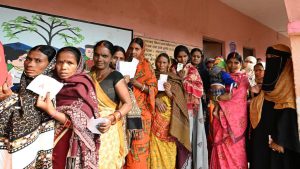Historic Voting in Bihar’s second phase election shatters records. Massive turnout in Seemanchal may reshape political fortunes for NDA and Grand Alliance as results approach on November 14.
By Dr. Mohammad Farooque, Qalam Times News Network
Kolkata, November 12, 2025
Historic Voting marked the second phase of the Bihar Assembly elections, witnessing an extraordinary voter turnout that shattered all previous records and turned political predictions upside down. By 5 p.m., the voter turnout had touched 67.14 percent, creating ripple effects not only in Bihar’s political landscape but also across the national stage. State BJP President Dilip Jaiswal claimed that the turnout could reach 70 percent, while RJD leader Tejashwi Yadav called the bumper voting a clear sign of a bumper victory.
Seemanchal Leads in Historic Voting

The Historic Voting pattern in Seemanchal drew special attention. The Muslim-majority districts of Kishanganj, Araria, Katihar, and Purnia registered unprecedented turnouts compared to 2020 and earlier elections. In Kishanganj alone, 76.26 percent of voters had cast their ballots by 5 p.m., with long queues of women marking the day’s defining image. Similar enthusiasm was recorded in Katihar (75.23%), Purnia (73.79%), Aurangabad (64.48%), Gaya (67.50%), Jamui (67.81%), Banka (68.91%), and other key constituencies. Analysts note that the strong participation of Muslim and Dalit voters could pose major challenges for the NDA alliance.
High Turnout and Political Implications
Historically, in Bihar, a Historic Voting trend in backward and marginalized regions has often favored anti-incumbency waves. In both 2015 and 2020, heavy voter engagement rang alarm bells for the ruling coalition. This heightened participation is significant because Muslims comprise between 40 and 70 percent of the population across Seemanchal’s 24 Assembly seats—crucial in determining Bihar’s political direction. While the turnout in 2020 ranged from 58 to 64 percent, the present wave has surpassed expectations despite reports of over 761,000 names being dropped from voter lists under the State Information Register (SIR), particularly affecting NDA-dominated areas.
Voter List Controversy and Transparency Debate
The deletion of voter names—12 percent in Purnia, 11.82 percent in Kishanganj, 8.2 percent in Katihar, and 7.5 percent in Araria—has sparked debate about electoral transparency. Officials attribute removals to deaths, migration, or other reasons, yet the opposition claims the process favored certain political interests, fueling controversies over fair conduct in the elections.
Exit Polls and a Divided Forecast
Exit polls paint a fascinating picture ahead of results day. Leading agencies including P-MARQ, Chanakya Strategy, Poll Street, People Pulse, JVC, Peoples Insight, and MATRIZ-IANS project NDA to secure between 130 and 167 seats, while the Grand Alliance is expected to win between 75 and 108. Though BJP and JD(U) are predicted to lead, the momentum of Historic Voting in Seemanchal and Muslim-majority areas may disrupt these forecasts. Analysts suggest that if Muslim and Dalit votes consolidate, the massive turnout could become a threat to the NDA; otherwise, signs still point toward the ruling alliance retaining its edge.
Democratic Awakening and Social Mobilization
The surge of Historic Voting reflects not just political calculations but a deeper democratic awakening. Citizens—particularly women and youth—have become the voice of accountability against institutional failures, unmet promises, and shifting political priorities. This wave of civic consciousness is turning the election season into a defining moment for Bihar’s political future. Results due on November 14 will reveal whether the bumper turnout proves to be a blessing for the NDA or signals the end of Nitish Kumar’s era and the rise of Tejashwi Yadav’s renewed political journey.







